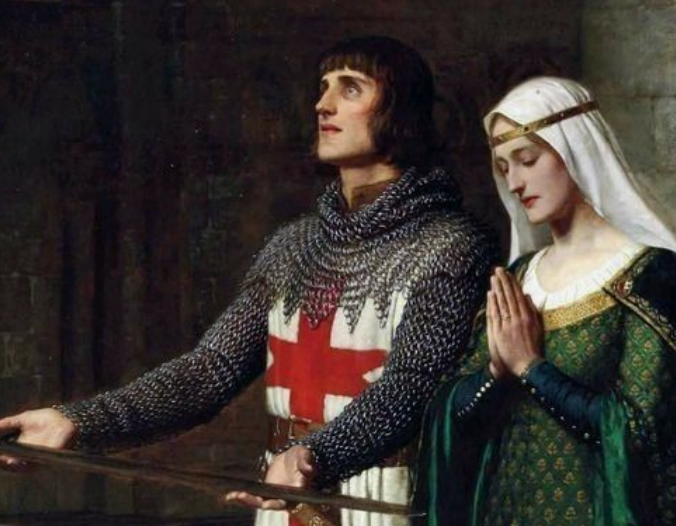Medieval Christmas
- Eli Stephens

- Dec 18, 2023
- 4 min read
It’s Christmas time so that means we’ll see Nativity scenes, Christmas trees, snow, and joy to mark the Birth of Jesus Christ. Today, Christmas is a time for the family to get together and show their love to one another with gifts, games, and sweets. And shockingly, in the Middle Ages, the sight wasn’t that much different. After a small context of tracing Christmas’ origins in the early Christian Church, you’ll see how the traditions have been the same across time, including a traditional annoyance with Christmas as well.
Christmas, a shortened form of Christ’s Mass, is a holiday to celebrate the Birth of Jesus Christ. Its origins can be found very early in the Christian Church. One of the earliest mentions of December 25th being used as the date to mark Christ’s birth is in the “Commentary of Daniel” written by Hippolytus of Rome, an early church father, putting the recognition of December 25th as early 205 A.D. Now this claim is widely disputed since these are later scholars quoting Hippolytus of Rome, so I’ll include the less disputed date of before 311 A.D. This year is noted because a group of Christians called the Donatists, considered heretical, held to many church traditions prior to the group’s schisms in 311 A.D. Later, they did not accept the introduction of any new feasts like the Feast of the Epiphany which means they only celebrated long-standing traditions. One of the traditions this group celebrated was Christmas or Christ’s Mass on December 25th. (Talley, 1986) So Christmas has been a long-standing holiday celebrated throughout the entire span of Christendom into the modern era. Let’s look at the Christmas traditions during the height of Christendom, the Middle Ages, to see how much has changed.
When one thinks of Christmas, the first thing that comes to mind is the Christmas Tree. A tall pine, fir, or spruce sitting in a living room covered with lights and ornaments. In the medieval era, this was the same image that came to mind. On December 24th, in the liturgical calendar of the Middle Ages, a feast was celebrated for Saints Adam and Eve from the Book of Genesis. A tradition commonly done during the feast was what’s called a “Paradise Play.” In it, actors ranging in age from kids to adults would reenact The Fall in a play. And since the only real notable setting in the Garden was the Tree of Knowledge of Good and Evil, they needed a tree for the play. With it being the end of December, the only tree available would have been a fir tree. So, they cut it down and decorated it with apples to represent the fruit of the tree. Side note: I would say this is also where the idea of the fruit Adam and Eve ate being an apple comes from, since Jewish rabbis teach the fruit is a fig. Once the play was over, on the next day, Christmas day, everyone would take down and eat the apples off the tree and celebrate another feast day. (Gulevich, 2003) Later on, a Pope declared the play to be heretical since it was marking a feast celebrated in the Eastern Orthodox Church, not the Roman Catholic Church, so most of Europe stopped doing the plays. They still kept the tradition of the Paradise Trees though, and just used it as a Christmas tradition instead. This brought about a Homeowner’s Association like ordinance in 1561 in the town of Alsace. The ordinance permitted one tree per household, and it said the tree could not be more than “eight shoes” in height. Another document from a traveler visiting Strasbourg in 1605 gives a vivid description of how Germans kept trees in their drawing rooms, covered in sugar decorations, apples, wafers, and many other assortments of sweets, bringing us to the modern Christmas tree and the modern consumption of Christmas sweets.
Another common sight to see around Christmas time is the nativity scene. Statues outside of people’s homes are used to depict the Birth of Jesus Christ as described in the Gospels of Luke and Matthew. This tradition was started in 1223 A.D. by none other than Saint Francis of Assisi, a Saint who had devoted much of his life to Christ. When he was in Greccio, Saint Francis wanted to celebrate the Birth of the Baby Jesus. He is quoted as saying, “I want to do something that will recall the memory of that Child who was born in Bethlehem, to see with bodily eyes the inconveniences of his infancy, how he lay in the manger, and how the ox and ass stood by.” This is where he came up with The Presepio at Greccio. He made an improvised manger inside a cave and then asked for a donkey and ox. He then invited all of the townspeople and they celebrated the Nativity through the night with songs and praises, creating what would become the modern Nativity Scene. (Bonaventure, 1263, pp. 110-112)
Here we see a Modern Christmas and a Medieval Christmas didn’t really differ much. Trees, Nativity scenes, sweets, and the neighborhood stickler have been with Christmas since the time of castles, kings, princesses, and knights. It’s always been a tradition of joy and happiness, and, God-willing, it always will be. So, with that, I doth wish you a Merry Christmas.










